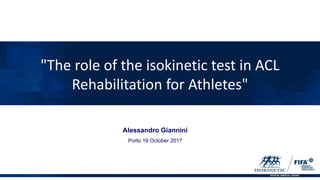The role of the isokinetic test in ACL Rehabilitation for Athletes
- 1. "The role of the isokinetic test in ACL Rehabilitation for Athletes" Alessandro Giannini Porto 19 October 2017
- 2. 1. Isokinetic test: merits and limitations 2. How to perform an isokinetic test of the knee 3. How to use the isokinetic test in ACL rehabilitation
- 3. History…. At the beginning of 900 the scientists asked for a very «simply» thing: So starts a journey that is not… Ended jet….. measure human force.
- 4. Force as a variable “The heat of shortening and the dynamic constants of muscle.” 1938 Archibald Hill
- 5. A «simply» solution ....keep a variable constant In 1967 J Perrine introduced a new speed controlled device which was described as 'cybernetic exercise'. His first machine was called the Cybex 1
- 6. Force (toque) change even at constant speed
- 7. Different type of effort Inertia is the resistance of any physical object to any change in its state of motion. This includes changes to the object's speed, direction, or state of rest.
- 8. But can we control muscle force consciously? What does Maximal Volountary Contraction (MVC) really mean? Trought burst superimposition we can increase muscle force up to 20% You can not really use this 20%?
- 9. Funny facts relative to muscle control the recruitment patterns of different types of motor unit are related to the mechanical requirements of the locomotor task. In facts …… More than reflex…..
- 10. Motor redundancy Motor movement and muscles contraction are organized based on the The purpose is to reduce noise of task relevant variable intention of the action
- 11. A briefly stop…. • Muscles have intrinsic property well described by force-velocity relationship • Each type of movement (isometric, isokinetic, isotonic, ballistic, ecc…) is unique and impose different demands on muscles • Force measured in different situations are related one another but are not the same thing • Spinal reflexes are very relevant to determine muscle activity and final force profile • Muscle are recruited and coordinated based on movement intention Key Points:
- 12. Which part have the Isokinetic test in ACL rehab?
- 14. How do we test strength?
- 15. Keep things simple Test: • 5 repetition • Concentric knee extension and flexion • At 60°/s • Using gravity correction • Use full range of motion • Measuring peak torque and H/Q We have told more about that in the workshop: Result: • Less than 10% difference in peak torque • H/Q ratio more than 60
- 16. When to test it • Extension as the controlateral knee • Minimal or no swelling • Good gait coordination • Minimal pain during walking (NRS 2-3) • Active flexion more than 120° As early as possible but…. Isokinetic test is safe…. …and reliable …. With Biodex IC is around 0,96-0,98 if well executed Czaplicki et al. 2015
- 17. Up to six months? On regular based on deficit until we achive <10% of deficit • Strength deficit (and kinematic alterations) more then 15% may still occur a year or longer after a reconstruction • The deficits are due to • Muscle atrophy • Neural inhibition that prevents the quadriceps from being fully activate • Arthrogenic mucle inhibition (AMI) Lewek et al. 2002
- 18. What is AMI
- 19. How may we fight AMI? 3 to 5 days after surgery Stokes et al. 1994 30 minute of cryotherapy BEFORE exercise Reduce AMI (for 20 minute) and increase peak torque Rice et al. 2009 HF TENS on the knee 120-150 Hz, pulse width, 0.1-0.15 sec Pietrosimeone et al. 2009 Aspiration Cryotherapy
- 20. How may we fight AMI? Neuromuscular electrical stimulation During isometric contraction, 60°-90° knee flexion, at least 50% of MVIC Delitto et al. 1988 Mental Training 15 min/day, 3 sets of 10 imagined maximal knee isometric extensions Lebon et al. 2012 Start 7 days post-op, 20 min per day, 80% 1RM, 5×6 reps (2 min recovery), conc-eccentric Controlateral Training Papandreu et al. 2012
- 21. How to plan a correct strength program? If you are not able to design a performance training program for an athlete pre-injury, how are you able to effectively design a performance training program to return to competition after an injury? Bill Knowles
- 22. How to plan a correct strength program? 1. We need an adequate stimulus to “overwhelm” or “embarrass” the body a little so that it adapts slightly • Our body can’t adapts too much and the stimulus has to be hard to complete but not devastating 2. After a stimulus we need adequate rest 3. The body will adapt very specifically to the type of training that we are doing All type of training is based on three very simple concepts Steve Magness
- 23. How may we fight AMI? 1 RM Strenght trainingVelocity training
- 24. We need both type of training in a progression way We need to move from «general» to «specific» What “specific” is depends of athletes in front of us
- 25. This can be applied to any “level” of description
- 26. Which type of exercise we need? • Isokinetic? • Eccentric? • Concentric? • Isoinertial? But we have concluded that muscle is activated based on intention of movement rather than the precise type of muscular contraction involved…….
- 27. Take home message • With Isokinetic test we can make an «educated guess» of how much strength deficit we have • Reducing force deficit is an important part of rehabilitation but is not everything • Control AMI • Work from general to specific even to increase muscle force • Isokinetic training play a rule but do not use just that one
- 28. How may we fight AMI?





























